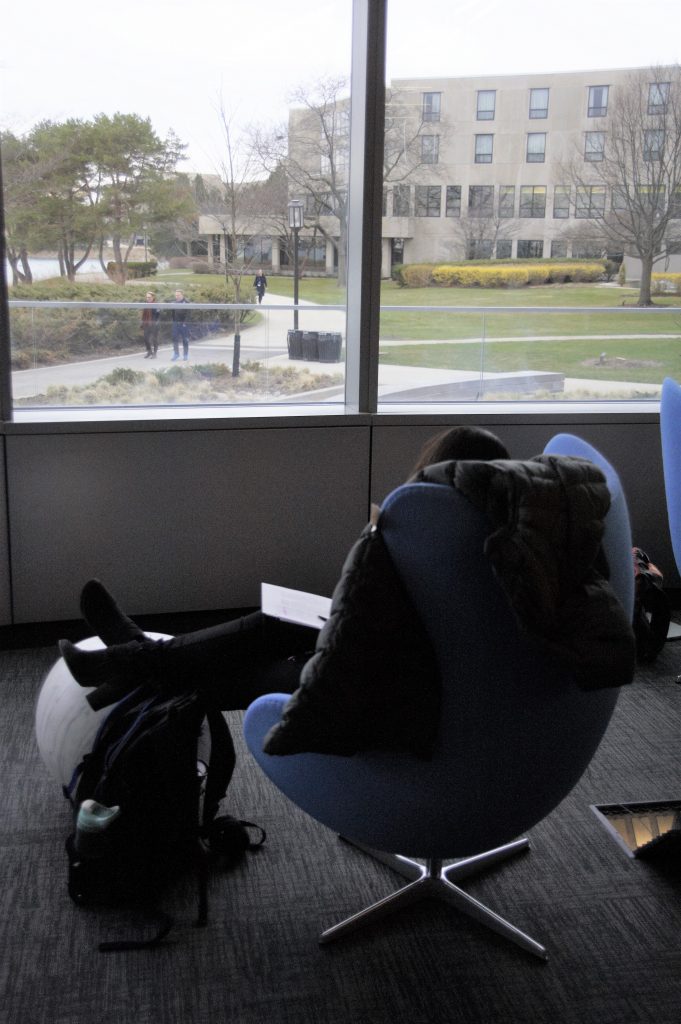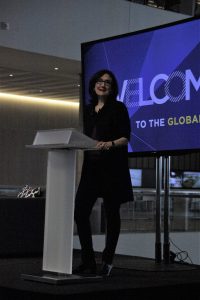A Building Where Students Can Work—and Live
For Kat Yang, a second-year student in Kellogg’s dual-degree MMM program, even more exciting than the stunning architecture and flexible design is the degree to which the Global Hub was built to fit into her life. “My day yesterday started at 8:30 a.m. and ended at 9:30 p.m.,” she says. “I was able to go to the gym—take care of my wellness—eat a great lunch and just explore different spaces and be able to move around during my different breaks—the old building was much less conducive to that,” she says. “As Kellogg students you spend so much of your time in the building—I didn’t realize that when I came to this school—so I really appreciate that this building allows me to be a whole person.”
Although many of the major design decisions were made well before the current classes arrived on campus, students still had significant input on many fronts. “The students are very engaged, and big things don’t get done at Kellogg without a really good collaboration between students and the school,” says Merrick. As an example, approximately 90 percent of the gym facilities are dedicated to cardio equipment, whereas initial plans called for more of a mix of weights and machines. “We would have really whiffed if we weren’t engaged with the students on that,” he says.
As a student in the MMM program—which confers upon graduates both an MBA and an M.S. in design innovation from the McCormick School of Engineering and Applied Science—Yang last year participated in a capstone project to evaluate the student experience in the Jacobs Center. One of the findings was that it in the Jake, the seating—almost all four-top tables—didn’t lend itself to multiple uses. Not so in the new building. “In the Marketplace—there are huge round tables if you want a big group to get together for lunch but there are also two-tops that you can combine into four-tops or six-tops,” she says. “It’s the same with all the other spaces in this building—it’s the same with the classrooms in that you can arrange the seating into long rows or smaller tables that are collaborative for small group discussions.”
Yang also was part of a student committee charged with evaluating food options, and as a result she got to participate in the coffee tasting. “I helped choose the coffee vendor that was going to be here—thank god it’s Intelligentsia,” she says. “We got the nicest vendor possible—and it was nice to feel like I had input in that process.” The committee also provided input to food service provider Aramark on the types of food options students would like to see, resulting in a more comprehensive salad bar, a brighter cafeteria space and a pizza oven, among other things. “I like the addition of curly fries, because I am a French fry person,” Yang adds.

Yang also helped test seats for the classrooms. “There were seven different chair options, and we got to sit in all of them and vote and write notes about them,” she says. “It was cool to be part of that entire process. When I went into the classroom yesterday and sat in the seat it was like, ‘I remember this chair!’” And though her top pick did not win, being consulted counted for a lot. Yang has also been working with Dean Merrick to create additional channels for students to continue to provide suggestions. “Because it’s a new building, and there are little details that we can continue to refine,” she says. “I am appreciative of how open the dean has been—I have literally spoken to him every day that I’ve been back in the building to talk about little improvements or how we can best gather student input.”
Says Merrick, “What distinguishes Kellogg students is the level of engagement they have in the overall experience. They are not just here to punch the clock, go to class and go home,” he says. “They want to engage and are seeking this more transformational experience.” Amenities such as wellness rooms for nursing parents, a gender-neutral restroom space, great food services, personal student lockers and quiet study lounges all are intended to help make it possible to spend the entire day at the building in comfort. “You can be here for 10 to 12 hours and it can feel like home—that enables a transformational experience.”
Some students have also expressed interest in having napping pods, he adds. “We haven’t done it, but that has been discussed and is something we will consider down the line.”
Don’t Build a New Building—Unless It’s This One
“Why Space Matters” panelist Kraemer, who is an executive partner at Chicago private equity firm Madison Dearborn Partners when he’s not teaching classes at Kellogg, lent a corporate perspective to both the panel and the building design process. He previously served as chairman and CEO of multi-billion-dollar global healthcare company Baxter International, Inc.
To start, though, he argued against the idea of a new building—in a call to Blount before she had even assumed her appointment as Kellogg’s dean. “There was this guy—I was at NYU, I had been announced as the Kellogg dean—and this guy calls me up and talks to me on the phone for an hour about why I shouldn’t do a building,” recalled the dean as she introduced the “Why Space Matters” panelists, drawing laughter from the audience.
“As a former CEO and CFO, when somebody tells me, ‘I want to build another building,’ my first reaction is, ‘Do you really need to do that?’” Kraemer explained. “I think of the cost, the economic outcome, the tradeoffs and what else you could do with the money—that’s sort of my CFO/CEO global business guy,” he continued. “But if you can create something that embodies what this school represents and really pull it off, it is almost a miracle.’

“You could look back and say the power of this school versus any other school is collaboration; it’s teamwork, having high impact, low ego and getting people together,” he continued. “We were able to pull that off for a long time in a pretty miserable environment. To be able to do that in this complex builds off of everything that made this school what it is today and now enables us to take it to the next level, which I think is truly remarkable.”
Blount, for her part, has absolutely no regrets. “In my mind, this building tells the world unequivocally that we are a contender—we are not and have never been a one-generation wonder,” she said. “Our university, alumni, faculty, staff and students have all stepped up to ensure Kellogg’s relevance and prominence for the 21st century,” she continued. “This building tells the world unequivocally that we are brave, we are visionary and we embrace our roots in the great city of Chicago. It reminds us all of what made Kellogg great: the ability to attract, shape and catalyze an unparalleled global community of grounded, courageous and collaborative leaders.”
Don’t miss this related post: The Glorious New Kellogg Global Hub, in Pictures.









